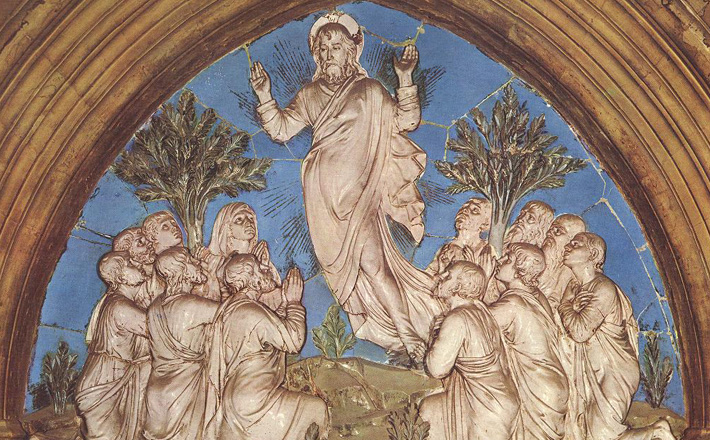Commentary on Acts 1:1-11
The Ascension seems like the poor cousin among church festivals: often overlooked, passed over without being missed.
A few congregations will worship on the Thursday that comes 40 days after Easter. More congregations will observe the Ascension on the following Sunday, thus bumping the seventh Sunday of Easter from the calendar. Most, I suspect, will simply not observe it at all.
This seems like poor treatment for one of the great ecumenical feasts, and an event that the writer of Luke-Acts thought important enough to narrate twice. Perhaps the scene of Jesus ascending on a cloud is a bit too reminiscent of Peter Pan. Perhaps we just can’t tolerate too much worship spilling into the week. More likely, I suspect, we really don’t like good-byes, and we don’t know quite how to celebrate this one.
The author of Acts, as any master story-teller, narrates the ascension without stopping to explain its theological significance, but there are at least three claims narrated here that are worth homiletical attention. The first is that the ascension is the narrative portrayal of Luke’s pervasive claim that Jesus is Lord. This point becomes more explicit later in Acts. In 2:33, Jesus’ ascension is the reason that he can send the Holy Spirit. In Acts 5:31 it is because of his ascension that Jesus can give repentance and forgiveness.
The cloud in our text is not a heavenly elevator; it is, as often in the Bible, a sign of God’s presence (consider the pillar of cloud in Exodus, or the cloud that comes at Jesus’ transfiguration in Luke 9). If we ask “Where did Jesus go?” perhaps the only adequate answer is that Jesus went to the Father — not to a place “up there” somewhere — but to be with the Father in love and in power. The ascension into the cloud is Jesus’ welcome into the Father’s presence.
This is not, however, simply a return to the way things were before. The world has changed, because now Jesus is its enthroned Lord. That means that Caesar is not, nor are any of the powers, pursuits, or promises that vie for control of our lives. In the accounts of both the ascension and the empty tomb, we hear about two men in dazzling white robes, asking “Why are you looking…?” Thus there is good exegetical reason to turn to the claim of the ascension in our Easter season. The writer of Luke-Acts ties the two events together, because the ascension clarifies what the resurrection means.
It doesn’t mean that there is life after death; it isn’t even a promise that we’ll go to heaven when we die. To proclaim Jesus’ resurrection is to claim that God has exalted him — the same Jesus who welcomed the sinners, who suffered and died in shame and rejection by this world — as Lord and Messiah (2:36). Jesus is God’s promise and plan for the whole world, and neither death nor any of its minions are able to stop that.
The second theme highlighted in the ascension story is that the stage is now set for the giving of the Spirit. Jesus’ going to the Father means that the Spirit will be poured out on God’s people (see, again, Acts 2:33). For now, the disciples must wait to receive “power when the Holy Spirit has come upon” them (verse 8). The language here is reminiscent of Gabriel’s words to Mary in Luke 1. Both the Gospel and the book of Acts thus begin with God’s Spirit moving in the world to bring something new: in Luke 1, the birth of the Messiah, and in Acts 1, the birth of the church and its witness.
For such things, we must wait and trust in God’s promise. Perhaps, as is so often the case with us, the disciples see no need to wait. They ask if “now” is the time to restore the kingdom to Israel. Luke’s Gospel, particularly the joyous outbursts by Mary, Zechariah, and Simeon in the first two chapters, makes clear that what happens in Jesus will truly be the fulfillment of God’s promises to Israel. But perhaps “restore” indicates a hope that is too small. What God has in mind is not just bringing Israel back to the “good ole’ days,” but bringing Israel to its yet-unrealized goal of being light to the whole world. The disciples may have thought they were on the verge of inheriting an old-style kingdom, when in fact they are at the edge of God’s mission to redeem all nations, a mission that will consume the rest of their lives (and ours).
Finally, this text is about the absence of Jesus (see 3:19-21). So, how do we live as Jesus’ followers without his visible, physical presence? The disciples have to be called away from staring up, in expectation and wonder, at where they last saw Jesus. They aren’t looking for the wrong thing (or, rather, the wrong person), but simply in the wrong place. “All that Jesus began to do and to teach” (verse 1; not clearly translated by NRSV, but see NIV or NET) doesn’t end with the ascension. The church continues to proclaim, to teach, to love, and to serve in Jesus’ name.
In the work of the Spirit (“the Spirit of Jesus”, 16:7) we encounter Jesus and what he continues to do. We aren’t left staring at where Jesus used to be (whether in history, or in our own life experiences, or in our supposedly settled opinions and interpretations). Not just although, but because he ascended, we continue to encounter Jesus through the preaching of the Word and the Sacraments, through the fellowship of the church, and through ministry with the poor and the oppressed. And because Jesus has ascended as our risen Lord, none of the other departures we experience (departures of relationships, of health, or of life itself) can harm us or rob us of God’s good promise. For that, we can and should celebrate The Ascension with praise and thanks.


May 12, 2013